Archive:The EU in the world - health
- Data from February 2014. Most recent data: Further Eurostat information, Main tables and Database. Planned article update: May 2015.
This article is part of a set of statistical articles based on Eurostat’s publication The EU in the world 2014.
The article focuses on public health issues such as healthcare expenditure, provision and resources, as well as the health status of populations and causes of death in the European Union (EU) and in the 15 non-EU countries from the Group of Twenty (G20). It gives an insight into health in the EU in comparison with the major economies in the rest of the world, such as its counterparts in the so-called Triad, Japan and the United States, and the BRICS composed of Brazil, Russia, India, China and South Africa.
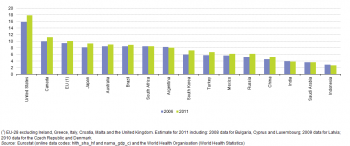
(% of GDP) - Source: Eurostat (hlth_sha_hf) and (nama_gdp_c) and the World Health Organisation (World Health Statistics)
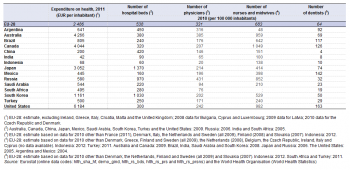
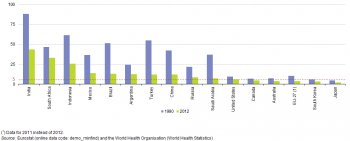
(infant deaths per 1 000 live births) - Source: Eurostat (demo_minfind) and the World Health Organisation (World Health Statistics)

(years) - Source: Eurostat (demo_mlexpec) and the World Health Organisation (World Health Statistics)
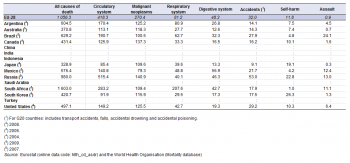
(per 100 000 inhabitants) - Source: Eurostat (hlth_cd_asdr) and the World Health Organisation (Mortality database)
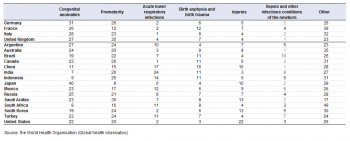
(%) - Source: Eurostat (hlth_cd_asdr) and the World Health Organisation (Global health observatory)
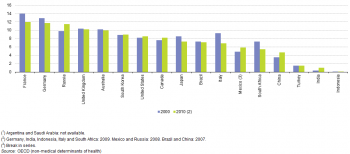
(litres per person) - Source: Eurostat (hlth_cd_asdr) and OECD (non-medical determinants of health)

(%) - Source: Eurostat (hlth_cd_asdr) and OECD (non-medical determinants of health)
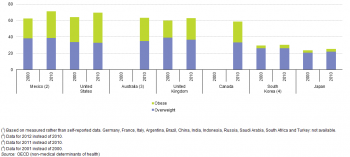
(%) - Source: Eurostat (hlth_cd_asdr) and OECD (non-medical determinants of health)
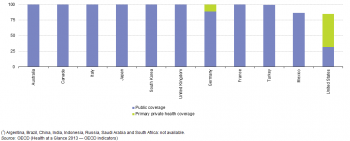
(%) - Source: Eurostat (hlth_cd_asdr) and OECD (Health at a Glance 2013 — OECD indicators)
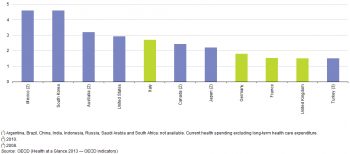
(%) - Source: Eurostat (hlth_cd_asdr) and OECD (Health at a Glance 2013 — OECD indicators)
Main statistical findings
Expenditure on health
Public expenditure exceeded private expenditure in most G20 members
Healthcare systems are organised and financed in different ways. Monetary and non-monetary statistics may be used to evaluate how a healthcare system aims to meet basic needs for healthcare, through measuring financial, human and technical resources within the healthcare sector.
Public expenditure on healthcare is often funded through government financing (general taxation) or social security funds. Private expenditure on healthcare mainly comes from direct household payments (also known as out-of-pocket expenditure) and private health insurance.
The United States had by far the highest expenditure on health relative to GDP, 17.9 % in 2011. Seven of the G20 members committed 8 % and 12 % of their GDP to health in 2011: Canada, the EU, Japan, Australia, Brazil, South Africa and Argentina. These were followed by a smaller grouping of South Korea, Turkey, Mexico and Russia (6 % to 7 % of GDP). China spent 5.2 % of its GDP on health with the remaining G20 members spending less than 4 % of GDP; the lowest relative expenditure was recorded for Indonesia (2.7 %). Relative to GDP, expenditure on health increased in nearly all G20 members between 2006 and 2011, with the exceptions of Argentina, Indonesia and India (where relative expenditure fell slightly). The largest increase was recorded for the United States, where health expenditure relative to GDP increased by 2 percentage points.
In broad terms, expenditure on health relative to GDP was higher in G20 members with a higher average level of income per capita, although there were a number of exceptions: Brazil and South Africa ranked higher in terms of their expenditure on health than they did in terms of GNI per capita, while Saudi Arabia, and to a lesser extent Russia and Australia, ranked lower.
Table 1 shows the absolute level of health expenditure per person — note that this is shown at current exchange rates and so does not reflect differences in price levels of healthcare among the G20 members; the other indicators in this table are non-monetary indicators and are therefore not affected by price level differences. An alternative measure to the relative expenditure on health as a percentage of GDP is provided by a ranking based on the absolute level of expenditure per inhabitant. This shows relatively high levels of expenditure per inhabitant in the United States, Australia, Canada, Japan and the EU-28, whereas Indonesia and India recorded by far the lowest ratios.
Healthcare resources
The number of hospital beds per 100 000 inhabitants in the EU-28 in 2010 was the fourth highest among G20 members
The need for hospital beds may be influenced by the relative importance of inpatient and outpatient care and the use of technical resources. The number of hospital beds per 100 000 inhabitants averaged 538 in the EU-28 in 2010 which was the fourth highest ratio among G20 members behind Japan, South Korea and Russia. The lowest availability of hospital beds relative to the size of the population was in India and Indonesia, both with less than 100 beds per 100 000 inhabitants (see Table 1).
One of the key indicators for measuring healthcare personnel is the total number of physicians, expressed per 100 000 inhabitants. The variation between the G20 members in the number of physicians was relatively low in comparison with the other personnel indicators in Table 1. In 2010, the highest number of physicians relative to the overall population size among the G20 members was recorded in Russia, followed by Australia and the EU-28; the lowest number was recorded in Indonesia. Argentina was the only G20 member to record more physicians than nurses and midwives and had by far the lowest number of nurses and midwives relative to population size.
Among the three indicators concerning healthcare personnel, the number of dentists per 100 000 inhabitants showed the greatest variation (when accounting for their relatively low number) among the G20 members. China, India and Indonesia recorded 10 or fewer dentists per 100 000 inhabitants while in South Africa and Saudi Arabia the ratio was more than twice this level. In the United States, Mexico, Canada and Brazil there were more than 100 dentists per 100 000 inhabitants.
Mortality
The average life expectancy at birth in the EU-28 was 80 years in 2011
The infant mortality rate presents the ratio between the number of deaths of children aged less than one year and the number of live births in the same reference period; the resulting value is generally expressed per 1 000 live births. This is one of the many indicators monitored by Eurostat under the heading ‘Investing in children’: more of these indicators are presented in the articles on population, living conditions and education. The progress made in medical healthcare services is reflected in the rapid decrease of infant mortality rates, with the world average — according to the United Nations World Population Prospects — falling from 135 deaths per 1 000 live births in the period 1950–55 to 42 deaths per 1 000 live births in the period 2005–10.
All of the G20 members recorded a fall in infant mortality rates between 1990 and 2012 as shown in Figure 2. The largest overall reductions (in percentage terms) were recorded by Saudi Arabia, Turkey, Brazil and China, while South Africa was the only G20 member where the infant mortality rate did not fall by at least 30 %.
Data for 2012 show that the lowest infant mortality rates among G20 members were recorded in Japan, South Korea, the EU-27 (2011 data), Australia and Canada, all of these countries averaged under 5 deaths per 1 000 live births. By contrast, infant mortality rates in South Africa, India and Indonesia were more than 10 times as high as in Japan and substantially higher than the rate in Mexico which had the next highest rate.
According to the United Nations World Population Prospects, the average life expectancy of a newborn baby in the world was 69 years during the period from 2005–10, which was 22 years higher than the corresponding figure for the period from 1950–55. Among the G20 members, the highest life expectancy at birth in 2011 was in Japan (83 years), while in Australia, Canada, South Korea and the EU-28 life expectancy also reached or passed 80 years. In four G20 members, life expectancy at birth remained below 70 years, ranging from 69 years in Indonesia and Russia and 65 years in India, down to 58 years in South Africa. The relatively low life expectancy for South Africa may be largely attributed to the impact of an HIV/AIDS epidemic.
All G20 members recorded an increase in life expectancy at birth between 2000 and 2011. The largest overall increases in life expectancy during this period were in China, South Korea and Turkey (an increase of 5 years), while the smallest increases in life expectancy were in Argentina, Mexico and South Africa (1 year).
Causes of death
In most G20 members the most common causes of death were diseases of the circulatory system
Statistics on causes of death may be used to evaluate the state of health and healthcare as well as to identify potential areas for preventive and medical-curative measures and research. As most causes of death vary with people’s age and sex, the use of standardised death rates improves comparability, as death rates can be measured independently of the population structure. Note that the standard reference population that is used in the compilation of Eurostat’s standardised death rates was re-computed during the course of 2013; the new European standard population is the unweighted average of the individual populations of EU and EFTA countries for five-year age bands calculated on the basis of 2010 population projections, averaged over the period 2011–30. This process of recalculation may explain the sometimes considerable differences if comparing the data presented here with data that has been previously published.
In most G20 members the two most common causes of death were diseases of the circulatory system and cancer (malignant neoplasms); the order was reversed in Japan, Canada, South Korea and Australia, while in South Africa death rates from diseases of the respiratory system (in particular tuberculosis) were higher than those from cancer. Among the causes of death shown in Table 2, death rates from cancer were the most similar among the G20 members, while the greatest variation was recorded in relation to death rates for assault, the latter being particularly high in Brazil.
Table 3 focuses on causes of death in 2010 for children aged less than five: presented as the distribution of all deaths among children aged less than five (rather than as standardised death rates). As can be seen, the main causes were very different from those commonly found in the population as a whole, with deaths related to congenital anomalies or premature birth the most prevalent. Among the very large range of other causes of child deaths, two specific cases stand out: 13 % of the deaths among children aged less than five years in India were caused by diarrhoeal diseases, while 28 % of deaths among children aged less than five years in South Africa were caused by HIV/AIDS; none of these other causes accounted for a substantial proportion of the overall deaths among children in the EU-28.
Figures 4–6 provide information on three non-medical health determinants, namely alcohol consumption, smoking and overweightness/obesity. Russia, Australia and three of the EU’s four G20 members (Italy was the exception) recorded the highest annual alcohol consumption among G20 members in 2010, at 10 litres or more of alcohol per person. The lowest average levels of alcohol consumption were recorded for Turkey, India and Indonesia. Between 2000 and 2010, annual alcohol consumption increased by an average of 1 litre or more per person in Mexico, China and Russia, although it should be noted that there is a break in the time series for Mexico. Average annual alcohol consumption fell by 1 litre or more in Germany, Japan, South Africa, France and Italy over the same period.
Russia reported by far the highest proportion of daily smokers, just over one third (33.8 %) of the population aged 15 and over. Around one quarter of the population in Turkey, Indonesia and China smoked daily, with the incidence of smoking among the populations of G20 members dropping below 15 % only in South Africa and India. Between 2000 and 2010, the incidence of smoking fell in all G20 members (for which data are available — see Figure 5), with the strongest falls in percentage point terms in Japan, South Africa, the United Kingdom, China and Turkey.
The most frequently used measure for assessing overweightness is based on the body mass index, which evaluates weight in relation to height. According to the World Health Organisation, adults with a body mass index between 25 and 30 are overweight and those with an index over 30 are obese. The data presented in Figure 6 are limited to those countries for which measured results are available, rather than self-reported data. Among this relatively small selection of G20 members, the highest proportions of the population that were either obese or overweight were observed for Mexico (71.2 %) and the United States (69.4 %). By far the lowest proportions were observed for South Korea and Japan, both of which recorded very low rates of obesity.
Access to healthcare
Near universal health insurance coverage among EU members of the G20
Access to healthcare is an aspect of the quality of life, an issue addressed by Eurostat as part of its project titled GDP and beyond and the OECD’s Better Life Initiative. The vast majority of the G20 members shown in Figure 7 reported universal health insurance coverage, with only Mexico (86.7 %) and the United States (84.9 %) reporting coverage below 99 %. Mexico and the United States also figured among the G20 members with the highest proportion of final household consumption expenditure allocated to out-of-pocket medical spending, in other words, medical expenditure not covered by health insurance. By contrast, the lowest out-of-pocket expenditures (as a proportion of final household consumption expenditure) were recorded by France, the United Kingdom and Turkey (see Figure 8).
Data sources and availability
The statistical data in this article were extracted during February 2014. The indicators are often compiled according to international — sometimes global — standards. Although most data are based on international concepts and definitions there may be certain discrepancies in the methods used to compile the data.
EU data
Most if not all of the indicators presented for the EU have been drawn from Eurobase, Eurostat’s online database. Eurobase is updated regularly, so there may be differences between data appearing in this publication and data that is subsequently downloaded. In exceptional cases some indicators for the EU have been extracted from international sources.
G20 countries from the rest of the world
For the 15 G20 countries that are not members of the EU, the data presented have generally been extracted from a range of international sources, most notably the World Health Organisation and the OECD. For some of the indicators shown a range of international statistical sources are available, each with their own policies and practices concerning data management (for example, concerning data validation, correction of errors, estimation of missing data, and frequency of updating). In general, attempts have been made to use only one source for each indicator in order to provide a comparable analysis between the countries.
Context
Health issues cut across a range of topics — including the provision of healthcare and protection from illness and accidents, such as consumer protection (food safety issues), workplace safety, environmental or social policies. The health statistics presented in this publication address public health issues such as healthcare expenditure, provision and resources as well as the health status of populations and causes of death.
In many developed countries life expectancy at birth has risen rapidly during the last century due to a number of factors, including reductions in infant mortality, rising living standards, improved lifestyles and better education, as well as advances in healthcare and medicine. Life expectancy at birth is one of the most commonly used indicators for analysing mortality. Indicators of health expectancies, such as healthy life years (also called disability-free life expectancy) have been developed to study whether extra years of life gained through increased longevity are spent in good or bad health; these focus on the quality of life spent in a healthy state, rather than total life spans.
See also
Further Eurostat information
Publications
- The EU in the world 2014
- Key figures on the enlargement countries — 2014 edition
- Pocketbook on Euro-Mediterranean statistics — 2013 edition
- The EU in the world 2013
- The European Union and the BRIC countries
- The European Union and the African Union — 2013 edition
- The European Union and the Republic of Korea — 2012
- Health statistics – Atlas on mortality in the European Union, 2009
Database
- Health care (hlth_care), see:
- Health care expenditure (hlth_sha)
- Health care expenditure - summary tables (hlth_sha_sum)
- Health care expenditure by financing agent (hlth_sha_hf)
- Health care expenditure - summary tables (hlth_sha_sum)
- Health care resources (hlth_res)
- Health care staff (hlth_staff)
- Nursing and caring professionals (hlth_rs_prsns)
- Physicians by medical speciality (hlth_rs_spec)
- Health personnel by NUTS 2 regions (hlth_rs_prsrg)
- Health care facilities (hlth_facil)
- Hospital beds by type of care (hlth_rs_bds)
- Health care staff (hlth_staff)
- Causes of death - standardised death rate per 100 000 inhabitants - annual Data (hlth_cd_asdr)
- Population (populat), see:
- Demography (pop)
- Demography - National data (demo)
- Demographic balance and crude rates (demo_gind)
- Mortality (demo_mor)
- Life expectancy by age and sex (demo_mlexpec)
- Infant mortality rates (demo_minfind)
- Demography - National data (demo)
- GDP and main components (nama_gdp)
- GDP and main components - Current prices (nama_gdp_c)
Dedicated section
Source data for tables and figures (MS Excel)
External links
- OECD
- World Health Organisation WHO